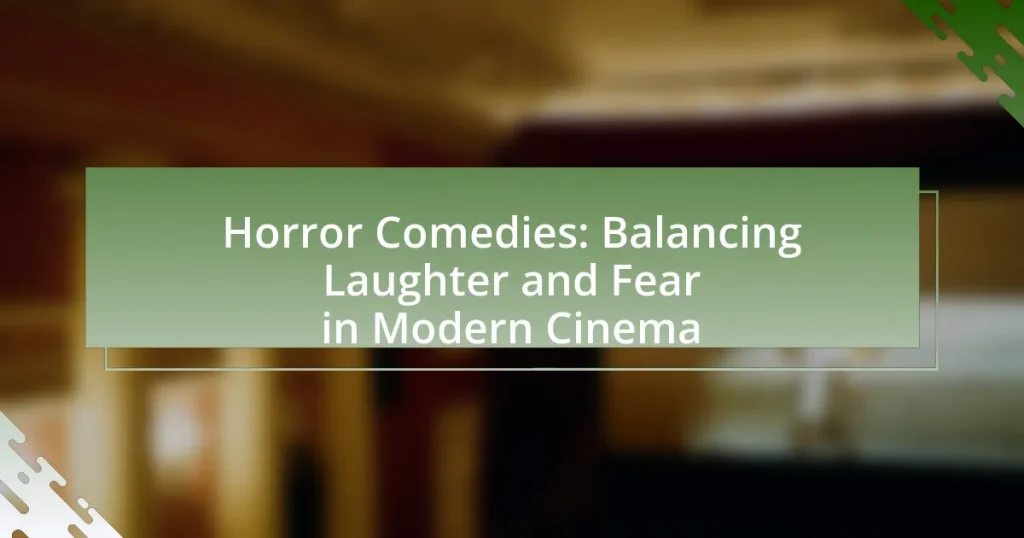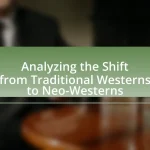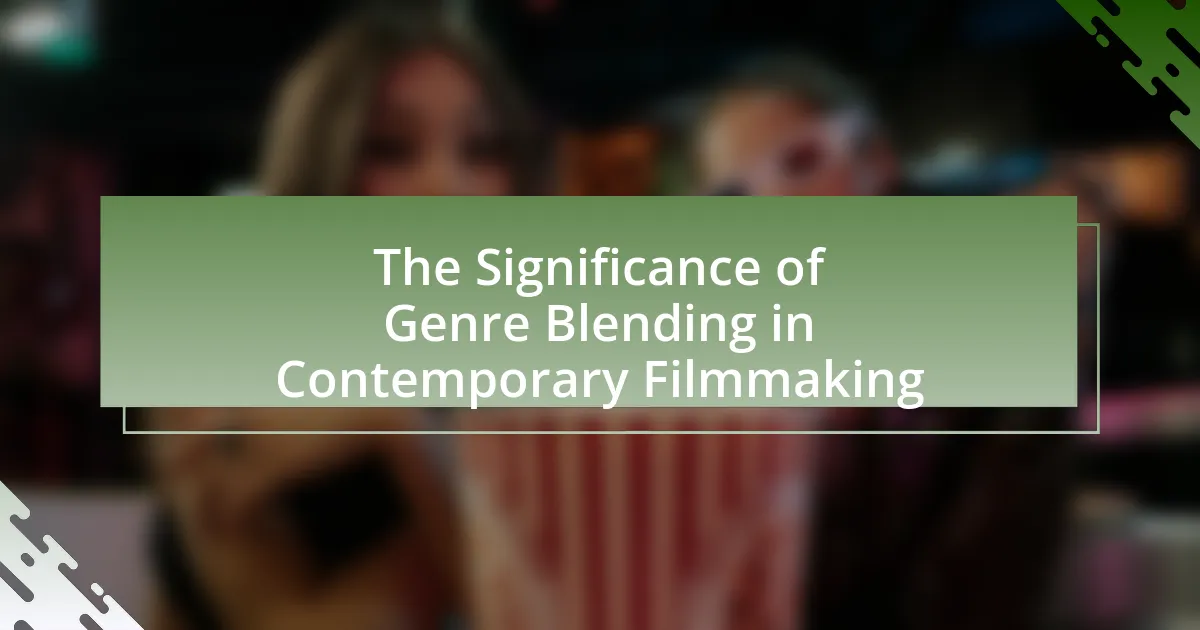Horror comedies are a film genre that combines elements of horror and comedy, creating narratives that evoke both fear and laughter. This article explores how horror comedies function by juxtaposing terrifying scenarios with humorous elements, utilizing techniques such as absurdity and character archetypes to enhance comedic moments. It examines the role of timing in balancing horror and comedy, the popularity of the genre in modern cinema, and the cultural factors that contribute to its appeal. Additionally, the article discusses key characteristics, themes, and the evolution of horror comedies, highlighting notable films and best practices for creating effective horror-comedy scripts.
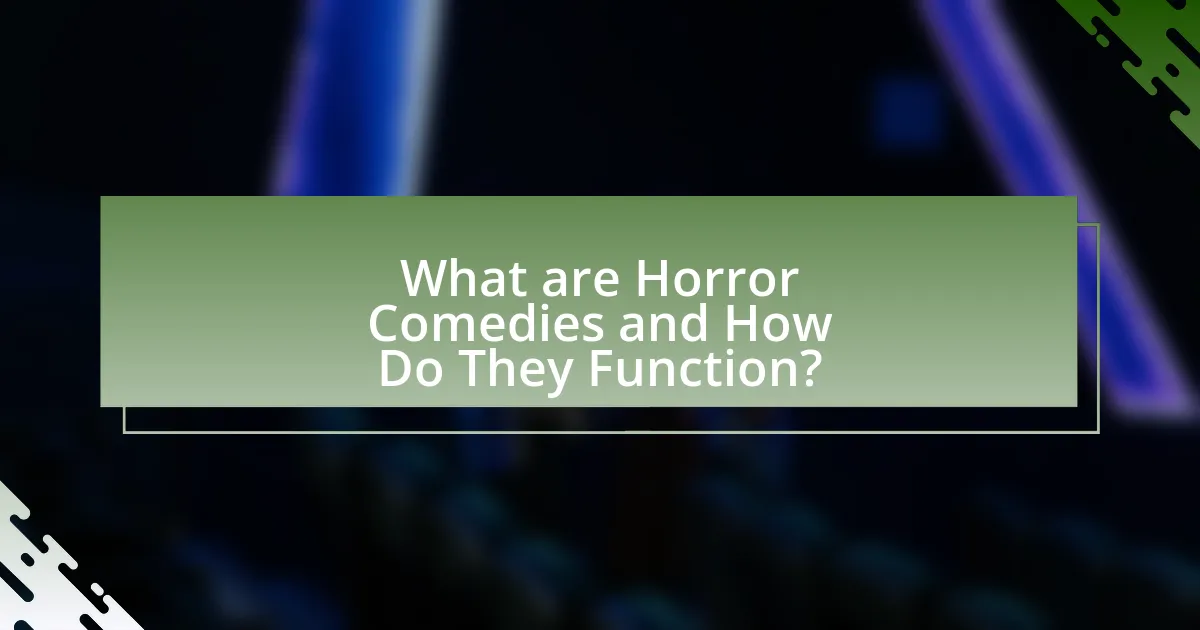
What are Horror Comedies and How Do They Function?
Horror comedies are a film genre that blends elements of horror and comedy, creating a unique narrative that elicits both fear and laughter. This genre functions by juxtaposing terrifying scenarios with humorous situations or dialogue, allowing audiences to experience a range of emotions simultaneously. For instance, films like “Shaun of the Dead” and “What We Do in the Shadows” effectively use comedic timing and absurdity to diffuse tension, making horror elements more palatable while still engaging viewers with suspenseful moments. The interplay between fear and humor can enhance the overall viewing experience, as laughter often serves as a coping mechanism for the fear induced by horror elements.
How do Horror Comedies blend elements of fear and humor?
Horror comedies blend elements of fear and humor by juxtaposing terrifying scenarios with comedic elements, creating a unique emotional experience. This genre often employs techniques such as absurdity, parody, and exaggerated characters to elicit laughter while simultaneously invoking fear. For instance, films like “Shaun of the Dead” utilize zombie apocalypse settings to explore human relationships humorously, allowing audiences to laugh at the absurdity of dire situations. The effectiveness of this blend is supported by psychological studies indicating that humor can act as a coping mechanism for fear, enabling viewers to engage with horror content without overwhelming anxiety.
What techniques are used to create comedic moments in horror settings?
Techniques used to create comedic moments in horror settings include juxtaposition, absurdity, and character archetypes. Juxtaposition involves placing humorous elements alongside terrifying scenarios, which can create a stark contrast that elicits laughter. Absurdity often manifests through exaggerated situations or illogical outcomes that defy expectations, making the horror elements seem ridiculous. Character archetypes, such as the clueless victim or the overconfident hero, can also contribute to humor by subverting typical horror tropes, leading to comedic interactions and outcomes. These techniques are effective in horror comedies, as they leverage the tension inherent in horror to amplify the humor, creating a unique viewing experience.
How does timing influence the balance between horror and comedy?
Timing is crucial in balancing horror and comedy, as it dictates the pacing of both fear and humor. Effective timing allows for the buildup of tension in horror, which can then be punctuated by comedic relief, creating a contrast that enhances both elements. For instance, a sudden scare followed immediately by a humorous line can amplify the shock and then provide a release, making the audience more receptive to both emotions. Studies in film theory suggest that the juxtaposition of horror and comedy relies heavily on timing to maintain audience engagement, as seen in films like “Shaun of the Dead,” where comedic moments are strategically placed after intense horror scenes to maximize their impact.
Why are Horror Comedies popular in modern cinema?
Horror comedies are popular in modern cinema because they effectively blend humor with horror elements, appealing to a wide audience. This genre allows viewers to experience fear in a controlled environment while simultaneously providing comic relief, which can make the horror less intense and more enjoyable. The success of films like “Shaun of the Dead” and “What We Do in the Shadows” demonstrates this appeal, as they have garnered critical acclaim and commercial success, showcasing the ability of horror comedies to attract diverse demographics. Additionally, the rise of streaming platforms has increased accessibility to these films, further contributing to their popularity.
What cultural factors contribute to the appeal of Horror Comedies?
Cultural factors contributing to the appeal of horror comedies include societal attitudes towards fear, humor as a coping mechanism, and the blending of genres that reflects contemporary anxieties. Societal attitudes towards fear have evolved, allowing audiences to engage with horror themes in a more playful context, which reduces the stigma associated with fear. Humor serves as a coping mechanism, enabling viewers to confront their fears in a safe environment, as evidenced by studies showing that laughter can alleviate stress and anxiety. Additionally, the blending of horror and comedy reflects contemporary anxieties, allowing filmmakers to address serious issues, such as societal fears and existential dread, through satire and parody, making the genre relevant and relatable.
How do audience expectations shape the success of Horror Comedies?
Audience expectations significantly shape the success of horror comedies by influencing how humor and horror elements are balanced. When viewers anticipate a blend of scares and laughs, their enjoyment hinges on the film’s ability to meet these dual expectations. For instance, successful horror comedies like “Shaun of the Dead” and “What We Do in the Shadows” effectively integrate comedic timing with horror tropes, leading to positive audience reception and box office success. Research indicates that films that align closely with audience expectations in genre blending tend to achieve higher ratings and viewer satisfaction, as seen in audience reviews and critical analyses.
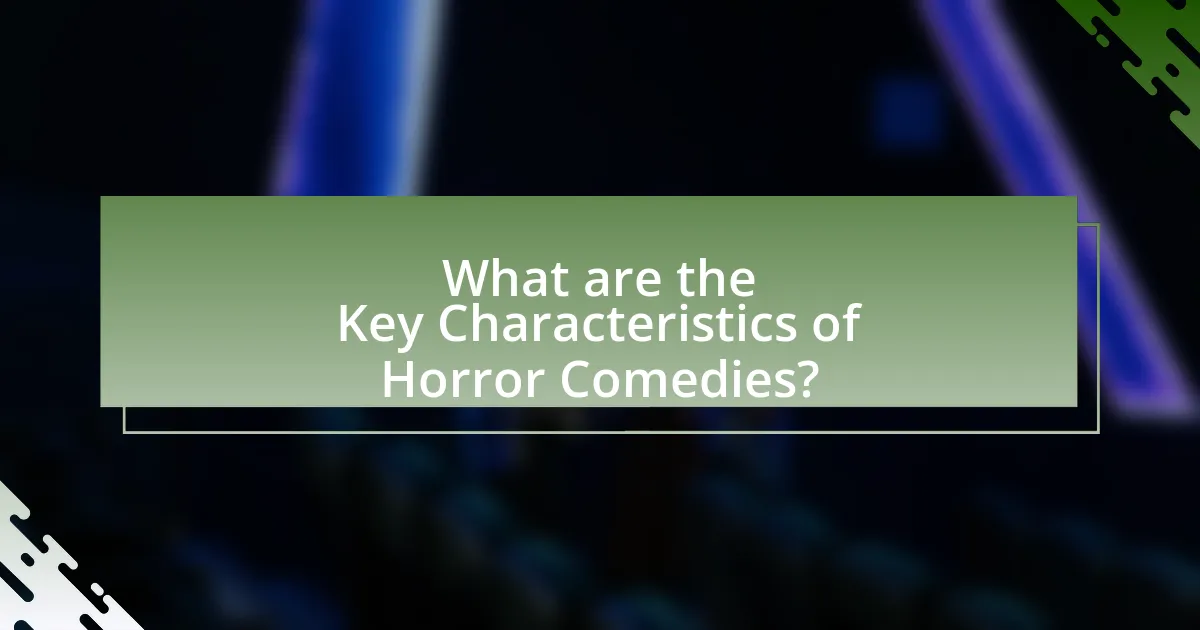
What are the Key Characteristics of Horror Comedies?
Horror comedies are characterized by the blending of comedic elements with traditional horror tropes, creating a unique genre that elicits both laughter and fear. Key characteristics include the use of humor to subvert horror clichés, exaggerated characters, and situations that create a juxtaposition between comedic and terrifying moments. Additionally, horror comedies often feature self-referential humor, where characters acknowledge the absurdity of their circumstances, and a playful tone that allows for the exploration of darker themes without losing the comedic aspect. Films like “Shaun of the Dead” exemplify these traits by combining zombie horror with witty dialogue and comedic scenarios, effectively balancing the two genres.
How do character archetypes differ in Horror Comedies compared to traditional horror films?
Character archetypes in horror comedies differ significantly from those in traditional horror films by incorporating humor and subverting typical roles. In horror comedies, characters often include exaggerated versions of classic archetypes, such as the cowardly hero or the quirky sidekick, which serve to create comedic situations rather than solely evoke fear. For instance, the “final girl” in traditional horror, who is typically portrayed as virtuous and resourceful, may be depicted as clumsy or sarcastic in horror comedies, thereby challenging the conventional narrative. This blending of humor with horror allows for a more diverse range of character interactions and dynamics, as seen in films like “Shaun of the Dead,” where characters navigate both comedic and terrifying scenarios.
What roles do protagonists and antagonists play in Horror Comedies?
Protagonists in horror comedies typically serve as relatable characters who navigate absurd and frightening situations, often providing humor through their reactions and decisions. Antagonists, on the other hand, embody the horror elements, such as monsters or villains, but are often portrayed in a way that allows for comedic interactions, creating a juxtaposition between fear and laughter. This dynamic allows the audience to experience tension while simultaneously finding humor in the absurdity of the scenarios. For example, films like “Shaun of the Dead” illustrate how the protagonist’s struggle against a zombie apocalypse is infused with comedic elements, making the horror more palatable and entertaining.
How do supporting characters enhance the comedic elements?
Supporting characters enhance the comedic elements by providing contrasting personalities and situations that amplify humor. Their unique traits often create comedic tension, allowing for humorous interactions with the main characters. For instance, a straight-laced character can highlight the absurdity of a more eccentric character’s actions, leading to comedic situations. Additionally, supporting characters often serve as comic relief, breaking tension during intense moments, which is crucial in horror comedies where balancing fear and laughter is essential. This dynamic is evident in films like “Shaun of the Dead,” where supporting characters contribute to both the humor and the horror, reinforcing the film’s comedic tone while maintaining the narrative’s stakes.
What themes are commonly explored in Horror Comedies?
Horror comedies commonly explore themes of absurdity, the juxtaposition of fear and humor, and the critique of societal norms. Absurdity is often highlighted through exaggerated characters and situations that challenge the boundaries of reality, making the horrific elements seem ludicrous. The juxtaposition of fear and humor allows for a unique blend where tension is diffused by comedic relief, creating a distinct viewing experience. Additionally, horror comedies frequently critique societal norms by using satire to address issues such as morality, relationships, and cultural taboos, often revealing the absurdities within these constructs. These themes are evident in films like “Shaun of the Dead,” which combines zombie horror with comedic elements while commenting on modern life.
How do social commentary and satire manifest in Horror Comedies?
Social commentary and satire in horror comedies manifest through the juxtaposition of humor and horror to critique societal norms and behaviors. This genre often uses exaggerated scenarios and characters to highlight absurdities in contemporary culture, such as consumerism, social anxieties, and moral dilemmas. For instance, films like “Get Out” utilize horror elements to address racial tensions and systemic racism, while simultaneously employing dark humor to engage the audience in critical reflection. The effectiveness of this approach lies in its ability to entertain while provoking thought, making the audience more receptive to the underlying messages.
What role does absurdity play in the narrative structure of Horror Comedies?
Absurdity serves as a crucial element in the narrative structure of horror comedies by juxtaposing comedic elements with horror tropes, creating a unique blend that enhances both fear and humor. This interplay allows for the subversion of traditional horror expectations, where characters may find themselves in ludicrous situations that highlight the absurdity of their predicaments, thus eliciting laughter even in terrifying contexts. For instance, films like “Shaun of the Dead” utilize absurd scenarios, such as mundane conversations occurring amidst a zombie apocalypse, to emphasize the ridiculousness of the situation while maintaining suspense. This technique not only entertains but also provides a coping mechanism for audiences, allowing them to engage with horror themes in a less threatening manner.

How Have Horror Comedies Evolved Over Time?
Horror comedies have evolved from early silent films to contemporary cinema by blending humor with horror elements to create a unique genre. Initially, films like “The Cabinet of Dr. Caligari” (1920) incorporated dark humor, but the genre gained prominence in the 1980s with movies like “Evil Dead II” (1987), which combined slapstick comedy with horror tropes. The 1990s introduced self-referential films such as “Scream” (1996), which parodied horror conventions while maintaining suspense. In the 2000s and beyond, films like “What We Do in the Shadows” (2014) and “Get Out” (2017) further diversified the genre, incorporating social commentary and innovative storytelling. This evolution reflects changing audience tastes and cultural contexts, demonstrating horror comedies’ adaptability and relevance in modern cinema.
What are the historical milestones in the development of Horror Comedies?
The historical milestones in the development of horror comedies include the release of “Abbott and Costello Meet Frankenstein” in 1948, which blended humor with classic horror elements, establishing a template for future films. In the 1980s, “The Evil Dead II” (1987) further defined the genre by combining slapstick comedy with horror, influencing subsequent works. The 1990s saw “Scream” (1996) parodying slasher films while maintaining horror elements, showcasing self-awareness in the genre. More recently, “What We Do in the Shadows” (2014) exemplified the mockumentary style, merging humor with vampire lore, and has been influential in contemporary horror comedies. Each of these milestones contributed to the evolution of horror comedies by integrating comedic elements with traditional horror tropes, shaping audience expectations and genre conventions.
How did early films influence the genre’s evolution?
Early films significantly influenced the evolution of the horror comedy genre by establishing foundational tropes and blending elements of fear and humor. The silent film era, particularly with works like “The Cabinet of Dr. Caligari” (1920) and “Nosferatu” (1922), introduced visual storytelling techniques that emphasized suspense and grotesque imagery, which later filmmakers adapted to incorporate comedic elements. For instance, the 1931 film “Frankenstein” showcased a blend of horror and dark humor, paving the way for subsequent films like “Abbott and Costello Meet Frankenstein” (1948), which directly merged comedic performances with horror themes. This interplay between fear and laughter became a hallmark of the genre, influencing modern horror comedies by demonstrating that humor could serve as a counterbalance to horror, thus enriching the narrative complexity and audience engagement.
What modern films have redefined the Horror Comedy genre?
Modern films that have redefined the Horror Comedy genre include “What We Do in the Shadows,” “Get Out,” and “The Cabin in the Woods.” “What We Do in the Shadows,” directed by Taika Waititi and Jemaine Clement, blends mockumentary style with vampire lore, showcasing humor in the mundane lives of supernatural beings. “Get Out,” directed by Jordan Peele, combines social commentary with horror elements, using dark humor to address racial issues. “The Cabin in the Woods,” directed by Drew Goddard, subverts traditional horror tropes while incorporating comedic elements, creating a meta-narrative that critiques the genre itself. These films have successfully merged humor with horror, influencing subsequent works and expanding the boundaries of the genre.
How do different cultures interpret Horror Comedies?
Different cultures interpret horror comedies through their unique social norms, historical contexts, and humor styles. For instance, in American culture, horror comedies often blend slapstick humor with horror tropes, as seen in films like “Shaun of the Dead,” which uses absurdity to diffuse fear. In contrast, Japanese horror comedies, such as “Ringu” parodies, often incorporate elements of folklore and societal fears, reflecting cultural anxieties about the supernatural. Additionally, Latin American interpretations frequently emphasize family dynamics and community, as seen in films like “Coco,” where humor is intertwined with themes of death and remembrance. These variations highlight how cultural backgrounds shape the balance between laughter and fear in horror comedies.
What are some notable international examples of Horror Comedies?
Notable international examples of horror comedies include “Shaun of the Dead” from the United Kingdom, “What We Do in the Shadows” from New Zealand, and “Tucker and Dale vs. Evil” from the United States. “Shaun of the Dead,” directed by Edgar Wright, cleverly blends zombie horror with humor, becoming a cult classic since its release in 2004. “What We Do in the Shadows,” directed by Jemaine Clement and Taika Waititi, offers a comedic take on vampire life, gaining acclaim for its unique mockumentary style. “Tucker and Dale vs. Evil,” released in 2010, subverts typical horror tropes by portraying the misunderstood protagonists as victims rather than villains, earning positive reviews for its humor and originality.
How do cultural differences affect humor and horror elements?
Cultural differences significantly influence humor and horror elements by shaping the context in which jokes and scares are understood. For instance, humor often relies on shared cultural references, social norms, and language nuances, which can vary widely across cultures; what is funny in one culture may be offensive or nonsensical in another. Similarly, horror elements are deeply rooted in cultural fears and taboos, meaning that a horror trope that resonates in one culture may not evoke the same response in another. Research indicates that humor is often tied to cultural identity, as seen in the work of researchers like John Morreall, who emphasizes that humor reflects societal values and experiences. In horror, studies show that cultural context can dictate the effectiveness of fear-inducing elements, as demonstrated in films like “The Ring,” which adapts Japanese horror tropes that may not translate effectively in Western contexts. Thus, both humor and horror are intricately linked to cultural frameworks, affecting their reception and impact.
What are the Best Practices for Creating Effective Horror Comedies?
The best practices for creating effective horror comedies include blending humor and horror elements seamlessly, developing relatable characters, and maintaining a consistent tone throughout the narrative. Successful horror comedies, such as “Shaun of the Dead,” demonstrate that the juxtaposition of comedic situations with genuine scares can enhance both genres. Additionally, utilizing clever dialogue and situational comedy can elevate the humor while still respecting horror conventions. Research indicates that audiences respond positively when comedic relief is strategically placed after tense moments, allowing for a balanced emotional experience.
How can filmmakers balance horror and comedy without losing impact?
Filmmakers can balance horror and comedy without losing impact by carefully timing comedic relief to enhance rather than detract from the tension. Effective use of pacing allows filmmakers to build suspense before introducing humor, creating a contrast that amplifies both elements. For instance, films like “Shaun of the Dead” demonstrate this balance by interspersing comedic moments during high-stakes scenarios, which maintains audience engagement and emotional investment. Research indicates that the juxtaposition of fear and laughter can lead to heightened emotional responses, as seen in studies on audience reactions to horror-comedy hybrids. This strategic interplay ensures that neither genre overshadows the other, preserving the overall impact of the film.
What tips can writers follow to develop engaging Horror Comedy scripts?
Writers can develop engaging Horror Comedy scripts by blending humor with horror elements effectively. This involves creating relatable characters who face absurd situations, allowing for comedic relief amidst tension. Utilizing irony and satire can enhance the humor while maintaining the horror atmosphere. Additionally, pacing is crucial; alternating between suspenseful moments and comedic beats keeps the audience engaged. Incorporating unexpected twists can surprise viewers, making the humor more impactful. Successful examples, such as “Shaun of the Dead,” demonstrate how well-executed humor can complement horror, reinforcing the effectiveness of these techniques.
